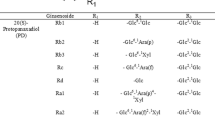Abstract
In this study, the major ginsenoside Rb1 was transformed into the more pharmacologically active minor compound K by food grade Lactobacillus paralimentarius LH4, which was isolated from kimchi, a traditional Korean fermented food. The enzymatic reaction was analyzed by TLC, HPLC, and NMR. Using the cell-free enzyme of Lactobacillus paralimentarius LH4 at optimal conditions for 30 °C at pH 6.0, 1.0 mg ml−1 ginsenoside Rb1 was transformed into 0.52 mg ml−1 compound K within 72 h, with a corresponding molar conversion yield of 88 %. The cell-free enzyme hydrolyzed the two glucose moieties attached to the C-3 position and the outer glucose moiety attached to the C-20 position of the ginsenoside Rb1. The cell-free enzyme hydrolyzed the ginsenoside Rb1 along the following pathway: ginsenoside Rb1 → gypenoside XVII and ginsenoside Rd → ginsenoside F2 → compound K. Our results indicate that Lactobacillus paralimentarius LH4 has the potential to be applied for the preparation of compound K in the food industry.






Similar content being viewed by others
References
Akao T, Kida H, Kanaoka M, Hattori M, Kobashi K (1988) Intestinal bacterial hydrolysis is required for the appearance of compound K in ratplasma after oral administration of ginsenoside Rb1 from Panax ginseng. J Pharm Pharmacol 50:1155–1160
Chae S, Kang KA, Chang WY, Kim MJ, Lee SJ, Lee YS, Kim HS, Kim DH, Hyun JW (2009) Effect of compound K, a metabolite of ginseng saponin, combined with gamma-ray radiation in human lung cancer cells in vitro and in vivo. J Agric Food Chem 57:5777–5782
Chen GT, Yang M, Song Y, Lu ZQ, Zhang JQ, Huang HL, Wu LJ, Guo DA (2008) Microbial transformation of ginsenoside Rb1 by Acremonium strictum. Appl Microbiol Biotechnol 77:1345–1350
Cheng LQ, Kim MK, Lee JW, Lee YJ, Yang DC (2006) Conversion of major ginsenoside Rb1 to ginsenoside F2 by Caulobacter leidyia. Biotechnol Lett 28:1121–1127
Chi H, Ji GE (2005) Transformation of ginsenosides Rb1 and Re from Panax ginseng by food microorganisms. Biotechnol Lett 27:765–771
Christensen LP (2008) Ginsenosides. Chemistry, biosynthesis, analysis and potential health effects. Adv Food Nutr Res 55:1–99
Dong A, Ye M, Guo H, Zheng J, Guo D (2003) Microbial transformation of ginsenoside Rb1 by Rhizopus stolonifer and Curvularia lunata. Biotechnol Lett 25:339–344
Han Y, Sun B, Hu X, Zhang H, Jiang B, Spranger MI, Zhao Y (2007) Transformation of bioactive compounds by Fusarium sacchari fungus isolated from the soil-cultivated ginseng. J Agric Food Chem 55(23):9373–9379
Hou J, Xue J, Wang C, Liu L, Zhang D, Wang Z, Li W, Zheng Y, Sung C (2012) Microbial transformation of ginsenoside Rg3 to ginsenoside Rh2 by Esteya vermicola CNU 120806. World J Microbiol Biotechnol 28(4):1807–1811
Jung JY, Lee SH, Kim JM, Park MS, Bae JW, Hahn Y, Madsen EL, Jeon CO (2011) Metagenomic analysis of Kimchi, a traditional Korean fermented food. Appl Environ Microbiol 77:2264–2274
Keum YS, Park KK, Lee JM, Chun KS, Park JH, Lee SK, Kwon H, Surh YJ (2000) Antioxidant and anti-tumor promoting activities of the methanol extract of heat-processed ginseng. Cancer Lett 150:41–48
Kim WY, Kim JM, Han SB, Lee SK, Kim ND, Park MK, Kim CK, Park JH (2000) Steaming of ginseng at high temperature enhances biological activity. J Nat Prod 63:1702–1704
Lee HU, Bae EA, Han MJ, Kim NJ, Kim DH (2005) Hepatoprotective effect of ginsenoside Rb1 and compound K on tertbutyl hydroperoxide-induced liver injury. Liver Int 25:1069–1073
Mochizuki M, Yoo YC, Matsuzawa K, Sato K, Saiki I, Tono-oka S (1995) Inhibitory effect of tumor metastasis in mice by saponins, ginsenoside Rb2, 20(R)- and 20(S)-ginsenoside Rg3, of Red ginseng. Biol Pharm Bull 18:1197–1202
Ni HX, Yu NJ, Yang XH (2010) The study of ginsenoside on PPAR gamma expression of mononuclear macrophage in type 2 diabetes. Mol Biol Rep 37:2975–2979
Noh KH, Son JW, Kim HJ, Oh DK (2009) Ginsenoside compound K production from ginseng root extract by a thermostable beta-glycosidase from Sulfolobussolfataricus. Biosci Biotechnol Biochem 73:316–321
Oh SH, Yin HQ, Lee BH (2004) Role of the Fas/Fas ligand death receptor pathway in ginseng saponin metabolite induced apoptosis in HepG2 cells. Arch Pharm Res 27:402–406
Park SJ, Youn SY, Ji GE, Park MS (2012) Whole cell biotransformation of major ginsenosides using Leuconostocs and Lactobacilli. Food Sci Biotechnol 21(3):839–844
Quan LH, Cheng LQ, Kim HB, Kim JH, Son NR, Kim SY, Jin HO, Yang DC (2010) Bioconversion of ginsenoside Rd into compound K by Lactobacillus pentosus DC101 isolated from Kimchi. J Ginseng Res 34:288–295
Quan LH, Piao JY, Min JW, Yang DU, Lee HN, Yang DC (2011) Bioconversion of ginsenoside Rb1 into compound K by Leuconostoc citreum LH1 isolated from Kimchi. Braz J Microbiol 42:1227–1237
Tawab MA, Bahr U, Karas M, Wurglics M, Schubert-Zsilavecz M (2003) Degradation of ginsenosides in humans after oral administration. Drug Metab Dispos 31:1065–1071
Wakabayashi C, Hasegawa H, Murata J, Saiki I (1997) In vivo anti metastatic action of ginseng protopanaxadiol saponins is based on their intestinal bacterial metabolites after oral administration. Oncol Res 9:411–417
Wakabayashi C, Murakami K, Hasegawa H, Murata J, Saiki I (1998) An intestinal bacterial metabolite of ginseng protopanaxadiol saponins has the ability to induce apoptosis in tumor cells. Biochem Biophys Res Commun 246:725–730
Wang BX, Cui JC, Liu AJ, Wu SK (1983) Studies on the anti-fatigue effect of the saponins of stems and leaves of Panax ginseng (SSLG). J Tradit Chin Med 3:89–94
Wu JY, Gardner BH, Murphy CI, Seals JR, Kensil CR, Recchia J (1992) Saponin adjuvant enhancement of antigen-specific immune responses to an experimental HIV-1 vaccine. J Immunol 148:1519–1525
Acknowledgments
This research was supported by iPET (# 309019-3 & # 111035-3), Korea Institute of Planning and Evaluation for Technology in Food, Agriculture, Forestry and Fisheries, Republic of Korea.
Author information
Authors and Affiliations
Corresponding author
Rights and permissions
About this article
Cite this article
Quan, LH., Kim, YJ., Li, G.H. et al. Microbial transformation of ginsenoside Rb1 to compound K by Lactobacillus paralimentarius . World J Microbiol Biotechnol 29, 1001–1007 (2013). https://doi.org/10.1007/s11274-013-1260-1
Received:
Accepted:
Published:
Issue Date:
DOI: https://doi.org/10.1007/s11274-013-1260-1



